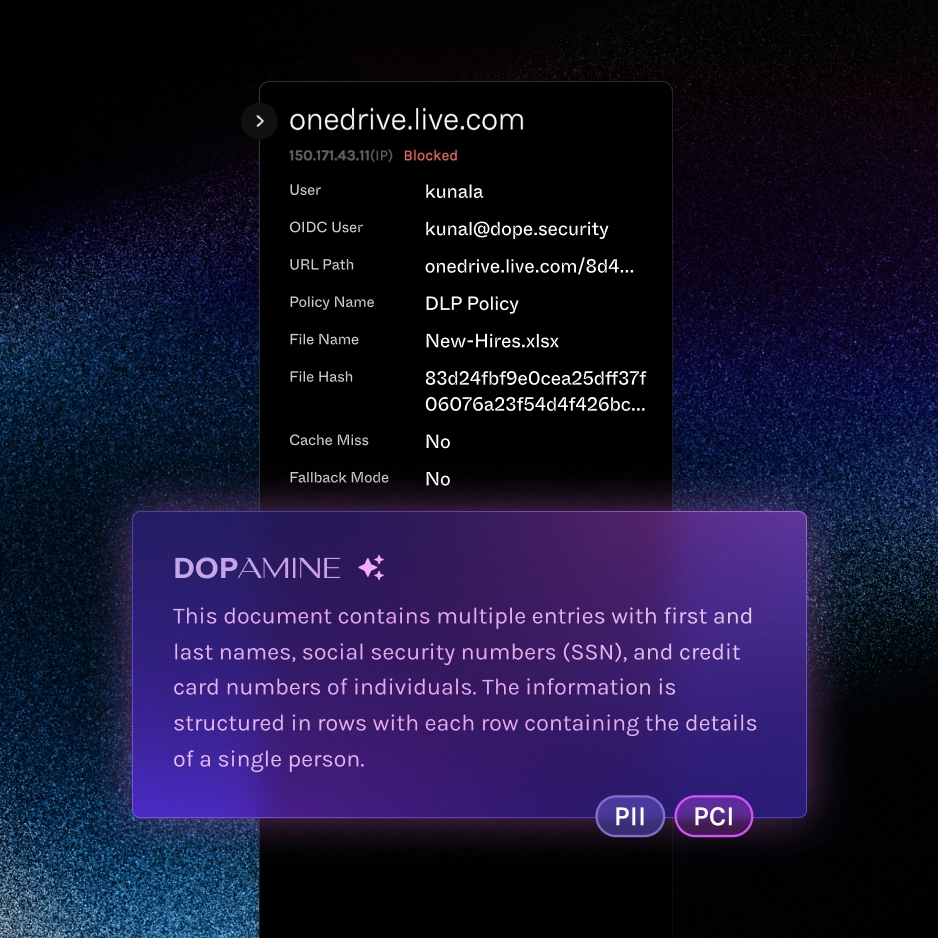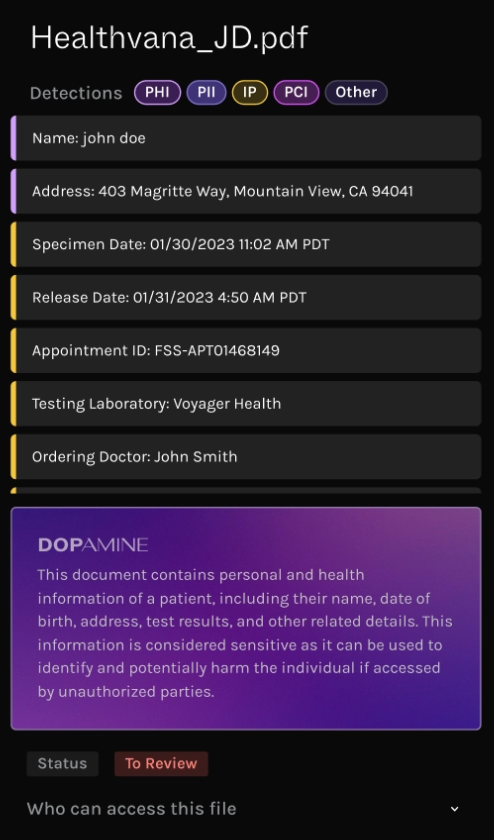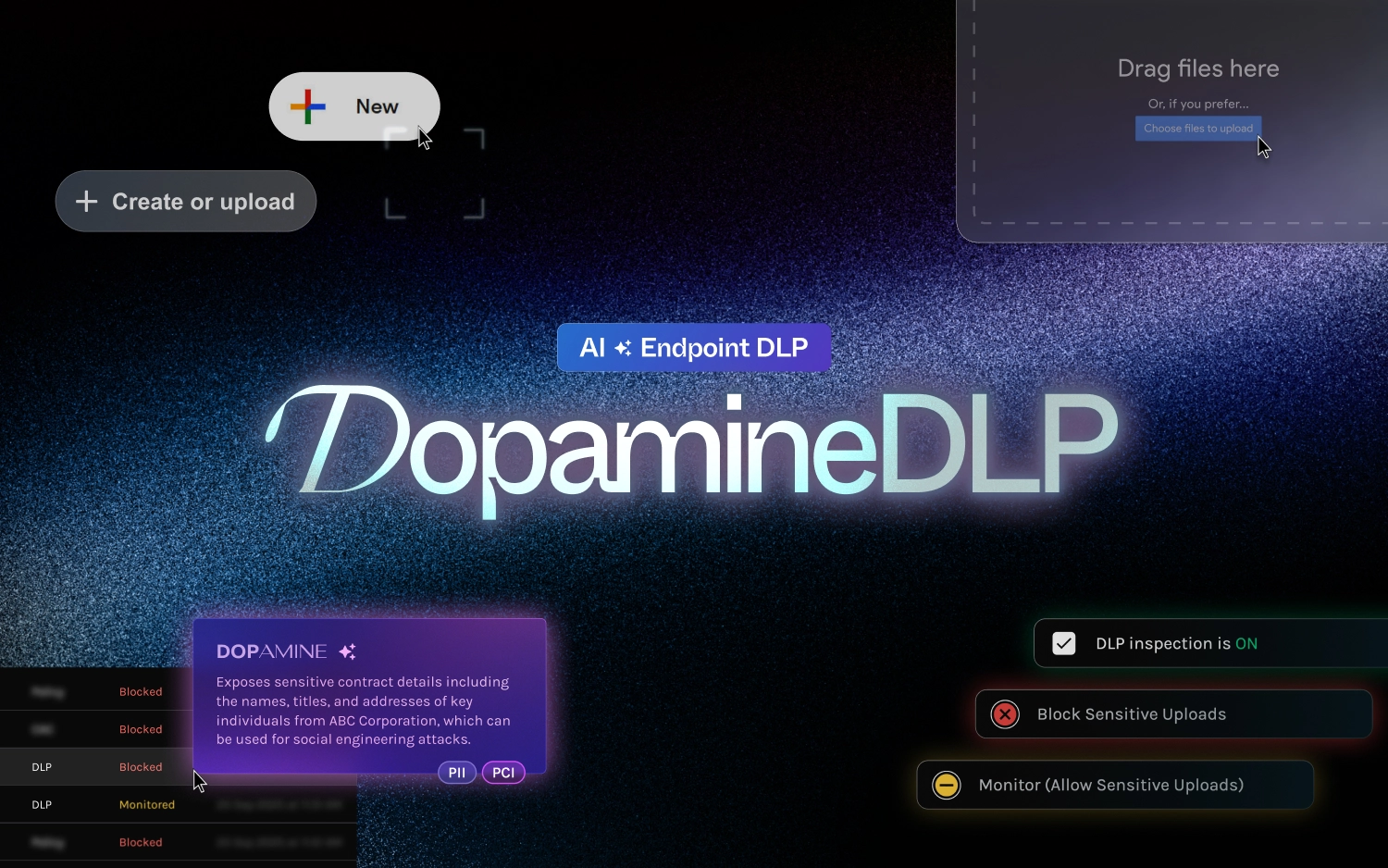DLP the dope way: AI-Powered Data Loss Prevention

DopamineDLP for data-in-motion + CASB Neural for data-at-rest
Legacy DLP buried teams in noisy alerts and endless tuning—dope.security replaces it, covering both data in motion (uploads) with DopamineDLP and data at rest (what’s already in Google Workspace/Microsoft 365) with CASB Neural. Together, they protect the two places your sensitive data moves and lives, all without rerouting traffic or babysitting regexes.
Why legacy DLP failed
Old-school DLP didn’t understand content. It tried to match patterns (like “16 digits = credit card”) and either over-blocked or under-protected, so most teams ended up leaving it in monitor-only mode or turning it off. Your data didn’t get safer, your queue just got louder.
In 2025, that’s unacceptable. You need a smarter DLP that reads what’s inside a file and acts with confidence across both the uploads your users make and the files already sitting in your SaaS drives.
One Console, two DLPs
Think of dope.security like a modern airport with two checkpoints:
- DopamineDLP—the “jet bridge” checkpoint for data in motion. It watches files as they’re uploaded to web apps (the #1 exfiltration path), leverages LLMs to understand the content, and then monitors & logs (aka allows), blocks & logs, or takes no action if its turned off. No detours through a cloud proxy, decisions happen on the device.
- CASB Neural—the “gate area” patrols for data at rest. It continuously analyzes what’s already in Google Workspace and Microsoft 365, identifying risky file sharing permissions and sensitive content so you can fix exposure before it becomes a problem.
Together, you get a unified DLP fabric with real-time control at the moment of upload, and continuous visibility on everything sitting in your cloud drives.
Data in motion, simplified: how DopamineDLP works
When someone tries to upload a file to a storage, web app, or AI tool (think Drive, OneDrive, Box, ChatGPT, etc.), DopamineDLP:
- Detects the upload
- Extracts the text from the file(s)
- Classifies that text via Dope Cloud using LLMs as sensitive/not sensitive (zero data retention)
- Enforces your policy: Off, Monitor, or Block
- Logs the outcome as a DLP violation for reporting and audit
No regexes. No hair-pinning through PoPs. Just fast, context-aware decisions at the endpoint.
The classifier reads meaning and story, not just patterns. That’s how we cut false positives while catching the real stuff—PII, PCI, PHI, and IP—so security can finally move from “monitor forever” to precise blocking.
Data at rest, covered: what CASB Neural adds
Uploads aren’t the only risk. Sensitive files can quietly become exposed over time—shared to “anyone with the link,” left open to external domains, or sitting in a public folder. CASB Neural focuses on the at-rest side of DLP. It analyzes file content and sharing posture in your SaaS suites (Google Workspace, Microsoft 365), surfaces risky exposure, and helps you fix it, fast. Pairing it with DopamineDLP closes the loop. Stop risky uploads now and clean up what’s already out there. DopamineDLP is your “don’t let sensitive files leave the laptop” control, while CASB Neural is your “find and fix what’s already shared too widely” safety net.
Dopamine AI Summaries: the Real Magic
DopamineAI summaries are short, plain-English descriptions that turn noisy DLP signals into human-readable context and next steps. Admins can move from “what happened?” to “what should we do?” on one screen.
For DopamineDLP, each summary explains who acted, what they touched, where it was headed, why the policy triggered, and what the system already did–warned, allowed with justification, or blocked.

For CASB Neural, it produces a clear and concise summary of what sensitive content exists in the file sitting in your Google or OneDrive, who can access it, the file location, and a one-click remediation to remove public access, public + external, or do nothing.

The practical value of Dopamine AI summaries is speed, accuracy, and accountability.
- Speed, because you triage in seconds without digging through logs
- Accuracy, because AI context cuts false positives and explains “why” in plain English;
- Accountability, because each summary provides a clear trail to see who did what and when, so you can start to build stronger policies for certain individuals and groups.
What this means for teams replacing legacy DLP
- Real coverage where it matters. Web uploads (data in motion) are the modern leak path. Cloud drives (data at rest) are the modern blast radius. You need both lenses to truly replace legacy DLP.
- Signal over noise. LLM-powered classifications shrink false positives so you can enforce, not just watch.
- Less moving parts. On-device enforcement means no fragile proxy detours or surprise latency. Policy is a simple switch, with clean exceptions and inherited defaults.
- Proof for audit. Clear violations, human-readable Dopamine AI summaries, all in a single console.
DLP shouldn’t slow down your business. With DopamineDLP protecting data in motion and CASB Neural securing data at rest, dope.security gives you modern coverage with fewer moving parts, fewer false positives, and way fewer headaches.











